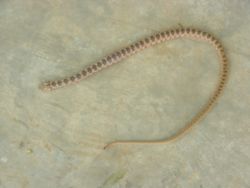- Coluber ventromaculatus
-
Hardwicke's Rat Snake 
A glossy-bellied racer on a garden plinth. Scientific classification Kingdom: Animalia Phylum: Chordata Class: Reptilia Order: Squamata Suborder: Serpentes Family: Colubridae Genus: Coluber Species: C. ventromaculatus Binomial name Coluber ventromaculatus
Gray & Hardwicke 1834The Glossy-bellied Racer or Hardwicke's Rat Snake or Gray's rat snake (Coluber ventromaculatus) is a species of rat-snake or Racer.
Contents
Distribution
SW Asia from north India to south Turkey, Pakistan, Afghanistan (Leviton 1959: 461), Uzbekistan, Iraq, Iran, Jordan (Disi 1993), Kuwait, Bahrain, Saudi Arabia (along the Arabian Sea) to Palestine.
Recorded in South Asia from Chitral in the north to Almora in Kumaon, Uttarakhand state, south to the Khandesh area in Maharashtra.
Status
Not uncommon.
Description
It is a graceful snake with smooth, round, elongate, gradually tapering body with the tail more than one-fourth the total length. It has a moderately narrow head. It ranges from grey, olive-brown, olive-green or dirty yellow. It has a series of black rhomboidal cross-bars on the back. The scales forming the cross-bars normally have colour on the edges only. The sides have similar smaller spots alternating with interspaces which may be broader or narrower than them. The belly is yellow to white with glossy scales.
The head is of the body-colour with or without symmetrical darkish markings. These would consist of :-
- Blackish spot between lores. A black streak obliquely placed below the eye. A black stripe from the temporal area to the gape.
- A cross-bar and two stripes on the nape.
Size
Adults are usually 90 to 120 cm in length and have been recorded to grow up to 1.28 m (Smith, 1943).
Identifying characteristics
- Costals in 19:19:15 or 13 rows.
- Anal 2.
- Supralabials (upper lip scales).
- The 4th, 5th and 6th touch the eye. The 4th and 9th are divided.
- In some rare cases, the 3rd and 8th may be divided in some case, with the 3rd, 4th and 5th touching the eye.
- The nostril occupies two-thirds of the suture between the nostrils.
- The tail is more than one-fourth the total length.
Races
- bengalensis
- India; Type locality: Bengal, description from fig 1 Plate 80 of Gray 1830-35; holotype destroyed.
- indusai
- Pakistan; Type locality: Upper and lower Indus Valley; no holotype specified [indusai].
Habitat
Inhabits mainly stony hillsides, open or cultivated land and sometimes in congested urban areas. It has been recorded in Pokaran district in the Thar desert also.
Habits
A fast active snake which gives rise to its name - racer. Normally seen in open country. When alarmed it quickly retreats into cover. It hibernates in winter. These snakes have been known to live as long as five years.
Diet
Largely feeds on lizards.
Reproduction
Oviparous. Gravid female racers have been obtained in early summer. About 9 eggs are laid. They hatch around September. The young snakes are 30 to 33 cm long.
Local names
- Arabic – Dawaid-al-khail.
- Urdu – Sagi.
References
- Daniels, J.C. Book of Indian Reptiles and Amphibians. (2002). BNHS. Oxford University Press. Mumbai.
- Barabanov, Andrei (2003) Taxonomic status of Coluber ventromaculatus bengalensis Khan et Khan, 2000 (Reptilia: Squamata: Colubridae). Russ. J. Herpetol. 9 (3):255 [2002]
- Gray. J. E. (1835) Illustrations of Indian Zoology, chiefly selected from the collection of Major - General Hardwicke. Vol. 2. London (1833-1834): 263 pp., 95 plates
- Günther, A. (1859) On the geographical distribution of reptiles. Ann. Mag. Nat. Hist. (3) 3: 221-237
- Schätti B; Wilson L D (1986) Coluber Linnaeus. Holarctic racers. Catalogue of American Amphibians and Reptiles No. 399 1986: 1-4
- Schätti B. & Monsch, P. (2004) Systematics and phylogenetic relationships of Whip snakes (Hierophis fitzinger and Zamenis andreana Werner 1917 (Reptilia: Squamata: Colubrinae). Rev. Suisse Zool. 111 (2): 239-256
- Smith, Malcolm A. (1943), The Fauna of British India, Ceylon and Burma including the whole of the Indo-Chinese Sub-region, Reptilia and Amphibia Vol III-Serpentes. Taylor and Francis, London.
- Whitaker, Romulus. Common Indian Snakes - A Field Guide. (2006) Revised edition. MacMillan India Ltd. New Delhi.
External links
Categories:- Colubrids
- Reptiles of Pakistan
Wikimedia Foundation. 2010.




